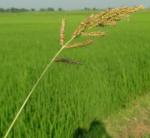Latin name
Echinochloa crus-galli (L.) P. Beauv
Family
Poaceae
Common name(s)
Common barnyardgrass
Synonym(s)
Panicum crus-galli L. (basionym), Panicum hispidulum Retz., Milium crus-galli (L.) Moench, Pennisetum crus-galli (L.) Baung
Geographical distribution
Asia: China, Japan, and Korea.
South and Southeast Asia: India, Indonesia, Cambodia, Lao PDR, Pakistan, Philippines, Sri Lanka, Thailand, and Vietnam.
Rest of the world: widespread in Africa, Europe, and America.
Morphology
Annual, erect, tufted or reclining at base; up to 200—cm—tall.
Stem: culms rooting at lower nodes, cylindrical, without hairs, and filled with white spongy pith.
Leaf: linear with a broad round base and narrow top; blade 10—40—cm—long; ligule absent.
Inflorescence: green to purplish, 10—25—cm—long loose compound racemes; spikelets more or less elliptical and pointed, usually slightly hairy; awns, if present, green to purplish, 2—5—mm—long.
Biology and ecology
Propagates by seed. Flowers throughout the year and can produce seeds within 60 days.
Echinochloa crus-galli prefers moist to wet land; in direct-seeded rice fields and wastelands. It is a common weed in swamps and aquatic places.
Agricultural importance
A serious weed of lowland rice due to its rapid growth, competitive ability, and capacity to multiply rapidly. The young shoots are eaten in Java. Serves as feed for animals in grasslands and wastelands.
Management
Cultural control: thorough land preparation for rice under wet or dry conditions can reduce infestations. Difficult to distinguish the weed seedlings from rice, which makes hand weeding difficult.
Biological control: the fungal pathogen Exserohilum monoceras shown to control this weed.
Chemical control: Oxadiazon, pretilachlor, pendimethalin or cyhalofop, thiobencarb, butachlor, and propanil mixtures with quinclorac or fenoxaprop.
Selected references
Galinato I, Moody K, Piggin. CM. 1999. Upland rice weeds of South and Southeast Asia. Manila (Philippines): International Rice Research Institute. 156 p.
Holm LG, Plucknett DL, Pancho JV, Herberger JP. 1977. The world's worst weeds: distribution and biology. Honolulu, Hawaii (USA): University of Hawaii Press. 609 p.Michael PW. 1978. Notes on Echinochloa in the Philippines. Philipp. J. Weed Sci. 5:16-18.Moody K. 1989. Weeds reported in rice in South and Southeast Asia. Manila (Philippines): International Rice Reseach Institute. 442 p.Moody K, Munroe CE, Lubigan RT, Paller Jr. EC. 1984. Major weeds of the Philippines. Weed Science Society of the Philippines. College, Laguna (Philippines): University of the Philippines at Los Baños. 328 p.Pancho JV, Obien Sr. 1995. Manual of ricefield weeds in the Philippines. Muñoz, Nueva Ecija (Philippines): Philippine Rice Research Institute. 543 p.
Contributors
JLA Catindig, RT Lubigan, and DE Johnson
